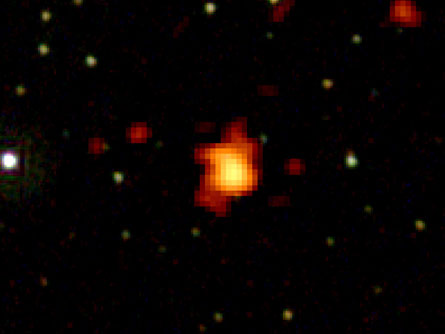Editor’s note: This story was updated February 19 after Michael Briggs of NASA’s Goddard Space Flight Center in Greenbelt., Md., reported that the gamma-ray burst known as GRB 080916C is the most energetic burst known.

VANCOUVER, Canada — Curtain up! Light the lights! In its first four months of monitoring the heavens from orbit, NASA’s Fermi Gamma-ray Space Telescope has unveiled the activity of celestial objects that emit powerful gamma rays — photons that pack 20 million to more than 300 billion times the energy of visible light. The orbiting observatory features the first detectors in space capable of recording the most energetic of these photons.
For now, Fermi’s flurry of first findings — which include new discoveries about gamma-ray bursts as well as the energetic radiation emitted by rapidly spinning stellar corpses called pulsars, several never before recorded — poses new puzzles. But ultimately the discoveries will offer new insight into the origin of these powerful emissions and the activity of some of the most enigmatic objects in the cosmos, says Peter Michelson of Stanford University, principal investigator of Fermi’s Large Area Telescope, the device on the observatory that records the high-energy emissions.
Michelson and his Stanford colleague Aurelien Bouvier presented some of the discoveries on December 8 in Vancouver at the Texas Symposium on Relativistic Astrophysics. Other reports will follow later this week at the conference.
Some of the new findings focus on gamma-ray bursts, the ephemeral flashes of light that signal the most powerful explosions in the universe since the Big Bang. Long-duration bursts — those lasting more than about a second or two — may be the birth cries of black holes, as jets of material zoom out of collapsing stars. Short bursts may signal the final coalescence of two elderly neutron stars or black holes.
In his talk, Bouvier announced that the Large Area Telescope had for the first time captured high-energy emissions from three gamma-ray bursts. In each case, the telescope did not record any energetic radiation until well after Fermi’s other instrument, the Gamma-ray Burst Monitor, had recorded the low-energy components of the same bursts.
The time delay between the onset of high- and low-energy emissions — which amounted to five seconds in a burst discovered on September 16 and dubbed GRB 080916C — suggests that the high-energy gamma rays from bursts might be produced at a different place or by different particles than the lower-energy radiation, says Bouvier.
It may be easier — and quicker — for electrons, which are relatively lightweight, to rev up to high speeds and crash into each other, producing the early, lower-energy part of these bursts, says Bouvier. It’s possible that protons, which are heavier and therefore take longer to accelerate, contribute to the higher-energy component some time later.
And there could be another, more intriguing — and much more speculative — explanation for at least part of the delay, Bouvier adds. The highest energy photons — 13 gigaelectron volts — from the September 16 event arrived 16.5 seconds later than the lowest energy emissions. Spectra of the visible-light afterglow of the burst reveal an origin in a remote galaxy 12.2 billion light-years from Earth.
Many theories of quantum gravity predict that spacetime on its tiniest scale isn’t continuous but is as malleable and variable as sea foam. Because of this foaminess, not all photons would travel at the same speed. Those with higher gravitational potential — higher energies, according to Einstein’s E=mc2 — would travel slightly slower through space and arrive slightly later than lower-energy photons. The effect would be tiny, but over a journey of 12.2 billion light-years, it might be detectable.
The September 16 event is also notable for other reasons, says Michael Briggs of NASA’s Goddard Space Flight Center in Greenbelt., Md. As recorded near Earth, the burst lasted for 23 minutes, 700 times longer than the average long-duration burst. Even after accounting for the stretching effect of cosmic expansion, that means the burst endured for 4 minutes when it was created 12.2 billion years ago.
It’s also the most powerful burst ever recorded, according to calculations. Its energy was probably concentrated in a focused beam, but if the radiation had spread out equally in all directions from the burst —the standard assumption astronomers use when estimating the energy of a burst — it converted the equivalent of 4.9 solar masses into gamma rays, Briggs and his colleagues report February 19 online in Science.
Also intriguing is that, unlike most bursts which start out more energetic and then cool down, the low-energy components of this burst began first but lasted for only 3 minutes. The high-energy component, after the delay, endured for 20 minutes.
Two of the three bursts detected by the Large Area Telescope — the September 16 event as well as a burst recorded on August 25 — belong to a class of bursts that last for more than a second. But on October 24, the telescope for the first time recorded extremely high-energy emissions from a short gamma-ray burst, one that lasted for only a few tenths of a second.
The Fermi data “support the picture that while the progenitors of long and short bursts are different … the sources of the outflow in both cases share many similarities and are probably sharing the same physical mechanism,” comments Ehud Nakar of the California Institute of Technology in Pasadena.
Also at the conference, Michelson reported that the Large Area Telescope has now recorded 15 previously unknown pulsars in our galaxy. These 15 rapidly rotating neutron stars, the dense cinders left behind when massive stars explode, have been found to emit only gamma rays, not pulses of radio waves as most of the 1,800 known pulsars do. If Fermi continues to find gamma-ray–only pulsars at such a high rate, astronomers would have the data to infer that the universe hosts as many gamma-ray pulsars as radio pulsars.







